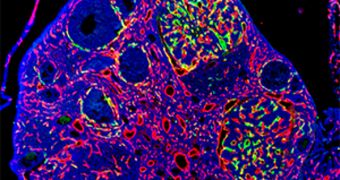A team of scientists in the United States reports the development of a new method for delivering gene therapy, which targets only diseased cells, while leaving normal, healthy tissue alone. The approach could potentially be used to treat dangerous conditions, including cancer.
The group is based at the Washington University in St. Louis (WUSL) School of Medicine. The study was conducted on lab mice, and involved the use of a deactivated virus as a carrying mechanism. This approach enabled researchers to inject the genes directly into the blood stream.
Furthermore, the approach is so targeted that the healing genes only make their way to diseased cells. This means that delivering chemotherapy drugs in this manner, for example, could alleviate some of the negative side-effects associated with this course of treatment.
During the experiments, the scientists used tumor blood vessels as a target. They were able to deliver the genes directly to these vessels without harming normal blood flow through the area neighboring the tumor. While this is just an early proof-of-concept study, results are very encouraging.
“Most current gene therapies in humans involve taking cells out of the body, modifying them and putting them back in,” says WUSL distinguished professor of radiation oncology, David T. Curiel, MD, PhD, the leader of the research.
“This limits gene therapy to conditions affecting tissues like the blood or bone marrow that can be removed, treated and returned to the patient. Today, even after 30 years of research, we can’t inject a viral vector to deliver a gene and have it go to the right place,” he goes on to say.
Such a “targetable injectable vector” was just developed by the WUSL team, working closely with colleagues at the Siteman Cancer Center at the Barnes -Jewish Hospital. The deactivated virus targets the inner lining of tumor blood vessels specifically, and disregards everything else.
Details of how the virus works were presented in a paper published in the December 23 issue of the peer-reviewed journal PLoS ONE, a publication of the Public Library of Science.
“We don’t want to kill tumor vessels. We want to hijack them and turn them into factories for producing molecules that alter the tumor microenvironment so that it no longer nurtures the tumor,” explains WUSL professor of urologic surgery, cell biology and physiology, Jeffrey M. Arbeit, MD.

 14 DAY TRIAL //
14 DAY TRIAL //